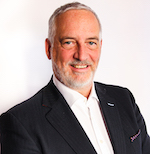Articles and News
Consumer Demand Driving Important Conversations About Sustainability | December 14, 2021 (0 comments)

Summit, NJ—Sustainability is one of the six seismic shifts taking place in the fine jewelry and watch market, according to State of Fashion: Watches and Jewellery, the 96-page report published earlier this year in a collaborative effort between McKinsey & Co. and Business of Fashion. Image: McKinsey & Co.
Related: McKinsey & Co. Outlines Six Seismic Shifts Coming In The Luxury Jewelry And Watch Industry
It turns out that sustainability is even more important than first thought. In a new podcast, two of the report’s authors say younger consumers won’t even consider a brand that doesn’t prioritize sustainability--something Mark Hanna, chief marketing officer of Berkshire Hathaway-owned Richline Group says the industry desperately needs to address.

Mark Hanna, CMO of Richline Group and a thought leader in sustainability in the jewelry and precious metals sector.
The McKinsey report contains some jaw-dropping negative statistics about precious gem and metal mining, such as “for every carat of diamond extracted, an estimated 250 metric tons of earth are shifted by miners who make as little as $3 a day in some regions,” and “Gold mining companies dump 180 metric tons of hazardous water into water streams every year.”
While these might be exceptions rather than the rule, perception is reality and consumers don’t necessarily know the difference between isolated bad actors and industry standards.
This is the driving force behind a new virtual conference series developed as a collaboration between Initiatives in Art and Culture (IAC) and Richline’s Hanna. Boldly Building the Future is a series of thought-leading conversations to address actionable solutions to central challenges and key issues facing the jewelry industry, from mine to market.
“Brand reputation matters more than ever and the onus is on business to solve the most pressing societal issues, including climate and the environment. Given the imperatives our industry faces, I am delighted to launch such an endeavor with Initiatives in Art and Culture, which has had an express commitment to such conversations for the past two years," says Hanna. "We hope, with these sessions, to inspire rapid industry transition and swift actions toward a Net Zero industry impact.”
The inaugural conversation, which took place December 13, tackled climate issues and the precious metals industry. Decade of Action: Climate and the Precious Metals Industry, addressed the directives of the Global Climate Conference (COP26), as it relates to industry climate action.
IAC president Lisa Koenigsberg praises Hanna as “the conscience of the industry who poses the large questions that few dare to contemplate.” Joining Hanna and Koenigsberg for the first discussion were Ruth Crowell, chief executive, London Bullion Market Association; John Mulligan, director and climate change lead, World Gold Council; and Grant Angwin, CEO, Angwin Precious Metals Services LLC. To hear a recap of “Decade of Action: Climate and the Precious Metals Industry” click here, call (646) 485-1952, or email info@artinitatives.com.



From left: Ruth Crowell, John Mulligan, Grant Angwin
Meanwhile, in this episode of the McKinsey on Consumer and Retail podcast, Tyler Harris and Alexander Thiel, two authors of the jewelry report, discuss the “sustainability surge” and other major shifts in how consumers buy fine jewelry and premium watches, and the implications for brands and companies. Harris, an associate partner in McKinsey’s New Jersey office, is a graduate gemologist with a special focus on the jewelry industry and retail operations. Thiel, a partner in McKinsey’s Zurich office, has deep expertise in retail, apparel, fashion, and luxury. Here are a few key excerpts from the podcast, moderated by Monica Toriello:
Monica Toriello: What surprised you as you were working on the report? Were there any trends that turned out to be stronger or weaker than you initially thought?
Alexander Thiel: One of the surprising things is that a few years ago people shopping for watches looked first for a design they liked. Then they looked for particular features, like movements or certain complications. Only after that did they look for a brand. Now, it’s completely different: consumers now look first for a brand that they identify with and that they want to wear as part of their public persona.
That is also one of the reasons why sustainability is so important. An individual watch can be sustainable, but it’s difficult to communicate that. For an entire brand, however, it’s much easier to put forward what you’re doing for sustainability. It’s also more obvious to the consumer if you’re not doing sustainable things.
Tyler Harris: On the jewelry side, in the past two years, the consumer has fundamentally changed as well and she has forced the industry to change along with her. During the COVID-19 pandemic, consumers couldn’t go into the flagship store and try on engagement rings in person. They had to go online. The trend of moving toward digital in jewelry really exploded. The same thing happened for sustainability. Our consumer research has shown that sustainability considerations across categories are really skyrocketing. The consumer cares much more about values and sustainable practices and ethics than she did even two or three years ago.
Toriello: Let’s talk about that “sustainability surge.” One of the projections you make is that by 2025, sustainability-influenced purchases will account for 20% to 30% of all fine-jewelry sales. That’s at least triple the sustainability-influenced purchases in 2019. That’s a sea change, right?
[What] about the attitude-behavior gap? What gives you confidence that consumers really mean it and really are considering sustainability as a factor in their buying decisions?
Thiel: The research we are doing is not just survey based. We do shop-alongs, we look at a lot of purchasing data, and we have partnerships with brands and manufacturers that give us certain insights. The attitude-behavior gap certainly exists, but we corrected for that.
Millennials are at a time and place in their life where many of them can afford a luxury purchase. For them, particularly when purchasing a highly emotive item into which they’ve put a lot of consideration and thought, the item needs to fit certain sustainability minimums. If the brand doesn’t have a sustainability agenda or sustainability credentials, then for many consumers it will just not be viable.
What we are seeing now is that the much more powerful sustainability argument is one of positive sustainability, where it’s not just mitigating the biggest negative externalities (like conflict diamonds) but really building a positive brand.
Harris: When you look at the search terms that consumers use when they are browsing online, the combination of “fine jewelry” or “fine watches” and “sustainability” in Google has skyrocketed. The other thing that I would cite is real growth in brands that are founded on sustainable principles. Mejuri is just one example of a brand founded on sustainable values that is doing remarkably well and growing very quickly. The uptick in those kinds of businesses shows that consumers are looking for these brands and voting with their wallets.







